Jimmy Fallon suggests you might want to pass on reading this book. (You only need to see the first minute)
Jimmy Fallon suggests you might want to pass on reading this book. (You only need to see the first minute)
Tree of Life Whitework Quilt
Artist Unknown
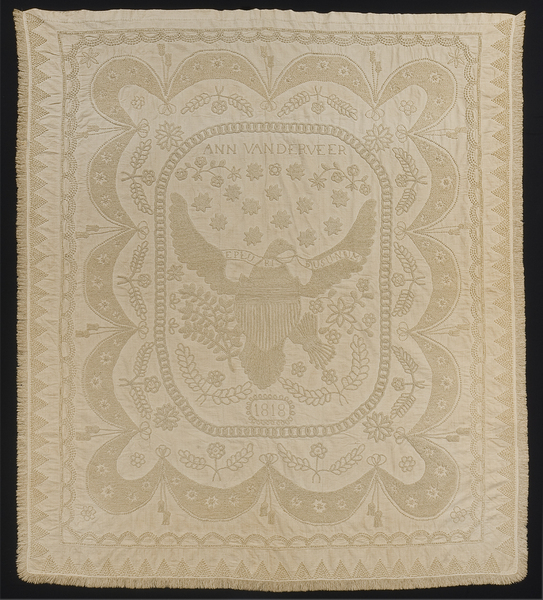
1818 Bedspread by Ann Vanderveer.
1998.0501 Courtesy of Winterthur Museum
The Subtle Elegance of Whitework
by Lilo Bowman
Candlewicking, or whitework, has been around for as long as women have taken thread to woven fabric. It seems, like most styles of threadwork, to come and go with the tastes and fashions of the time. Last fall, we spotted two stunning, award-winning quilts at the International Quilt Festival in Houston, that featured elements of whitework in their designs. As a result, we decided to share a little bit of history about this very subtle, yet eye-catching work.
The term whitework describes embroidery done on white fabric using white thread; it has always been one of the best ways for a needleworker to show off her skills. Worked in the very same, soft-spun thread as that used for for candle wicks, the project, once completed, would be washed in very hot water to shrink the fabric, while at the same time fluffing up and locking in the stitches. Generally, the embroidery was done on 100-percent unbleached cotton muslin, but the Ann Vanderveer piece shown above was done on a linen/cotton fabric called dimity; its warp is linen, while the weft is woven with a heavier cotton.
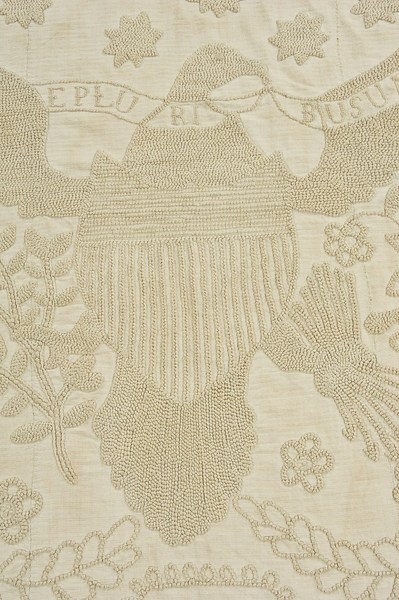
Ann Vanderveer (1818)998_0501 detail 6. Courtesy of Winterthur Museum
This beautiful bedcover features a spread-winged eagle (shown above) bearing olive branches and arrows in his talons, with the words "E PLURIBUS UNUM" embroidered on a banner in his beak. Amazingly, the embroidery designs--including swags, flowers, sawtooth points and tassels--are worked almost entirely in French knots (see the detail below).
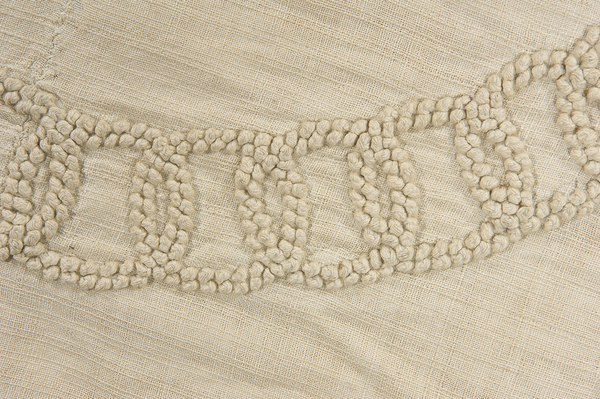
Ann Vanderveer (1818)1998_0501 detail 1. Courtesy of Winterthur Museum
Three sides of the bedcover are edged in woven cotton fringe, while the top has been hemmed. The entire piece measures approximately 34" wide and was constructed in three seamed panels. Originally, a plain cotton batting would have covered the back of the bedcovering.
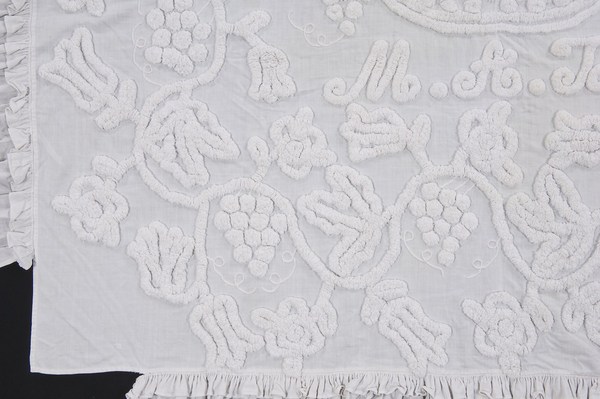
M. A. Todd (circa 1837)2000_0028_002 detail 7. Courtesy of Winterthur Museum
Whitework generally consisted of three-dimensional effects created with three types of stitches: tufting, knotting, or couching. "Tufted areas are made by running threads through the background material with running, satin, or cross-stitches. These stitches are raised from the surface in loops by passing the yarn over a spacer, such as a dowel or twig. After the spacer has been removed, the loops may be cut so that the strands of candlewicking stand straight up or contoured by shearing the pile. The roving remains firmly in place after the fabric is washed in hot water; as the fabric shrinks, the tufts of candlewicking are pulled together into tight balls." (Piecework, 1997)
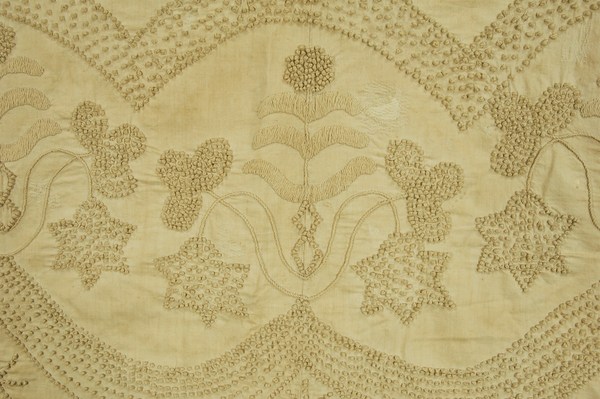
A R/3" (1800-1850) 1952_0345_005 detail 2. Courtesy of Winterthur Museum
French knots are small round knots created by wrapping the needle several times with the thread before the needle is re-inserted into the background fabric. French knots were used to fill large design areas or as an outlining device. Couching, wherein thread is laid and then tacked down at regular intervals, provided another, more subtle design element.
While these coverings certainly would have served a necessary utilitarian purpose, they also offered the creator the opportunity to showcase design elements that she felt important. One of the most famous of this type of bedcovering is the Katurah Reeve bedspread, shown below, which was created in 1820. This stunning piece is comprised of five rectangular panels, and "features a large, three-masted sailing ship in the center, complete with rigging and two flags, between which the date '1820' is worked. The flags appear upside down, an international signal of a ship in distress." (Winterthur Museum, Katurah Reeve Object report)
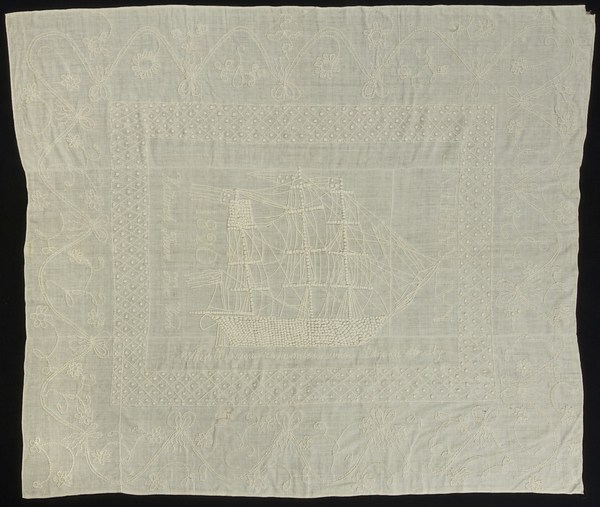
Katurah Reeve Her Work (1820) 1966.0139 overall. Courtesy of Winterthur Museum
The ship and its rigging are stitched with incredible realism. Katurah created the ship's roping by working the outline stitches at a very low angle. Other areas were worked using cut looped stitches and French knots.
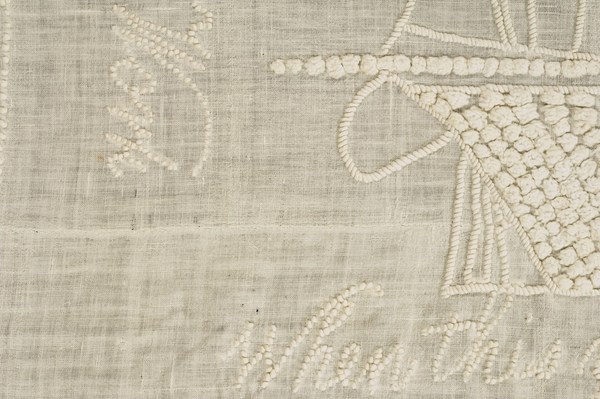
Katurah Reeve Her Work (1820) 1969_0236 detail 1. Courtesy of Winterthur Museum
The Patriot, the ship pictured in the bedcover, made headlines in newspapers up and down the East Coast on October 25, 1819; apparently, the Reeve family of Newburgh, NY, had relatives who were connected with this vessel. While en route from Mobile, AL, it was discovered that almost the entire crew had contracted yellow fever and that the ship had developed a major leak. A nearby Swedish ship, the Wilhelmine Catherine, rescued all the Patriot's crew. The article in the New York Evening Post from November 24, 1819 described the scene:
"On the 25th of October, fell in with the sloop Patriot, of New-York, captains Shiars, from Mobile bound to New York, in ballast; she was laying-to, with her colors half-mast, union down, in distress--wore ship and spoke her; on hailing, was informed she had sprung a leak, all hands sick but two, making so much water that she could not be kept free, and had all her sails split to pieces--captain S. and all hands, being compelled to abandon her, at their request, Captain Berg (of the Swedish ship Wilhelmine Catherine) took them on board, to save their lives, together with their effects, and brought them to this port.
Not all bedcoverings told such dramatic stories. Many examples feature popular motifs of the time: fruit-filled urns, medallions of flowers, swags, tassels, and floral and grape vines. It is extraordinary what the makers of these stunning bedcoverings were able to create using the most simple of elements.
My sincere thanks to the Winterthur Museum for so graciously sharing images from their whitework textile collection. To learn more about the Winterthur, click here.
Christa Watson at WeAllSew.com, shows you how to square up your quilt and add the binding by machine. It's a great way to finish any quilt!
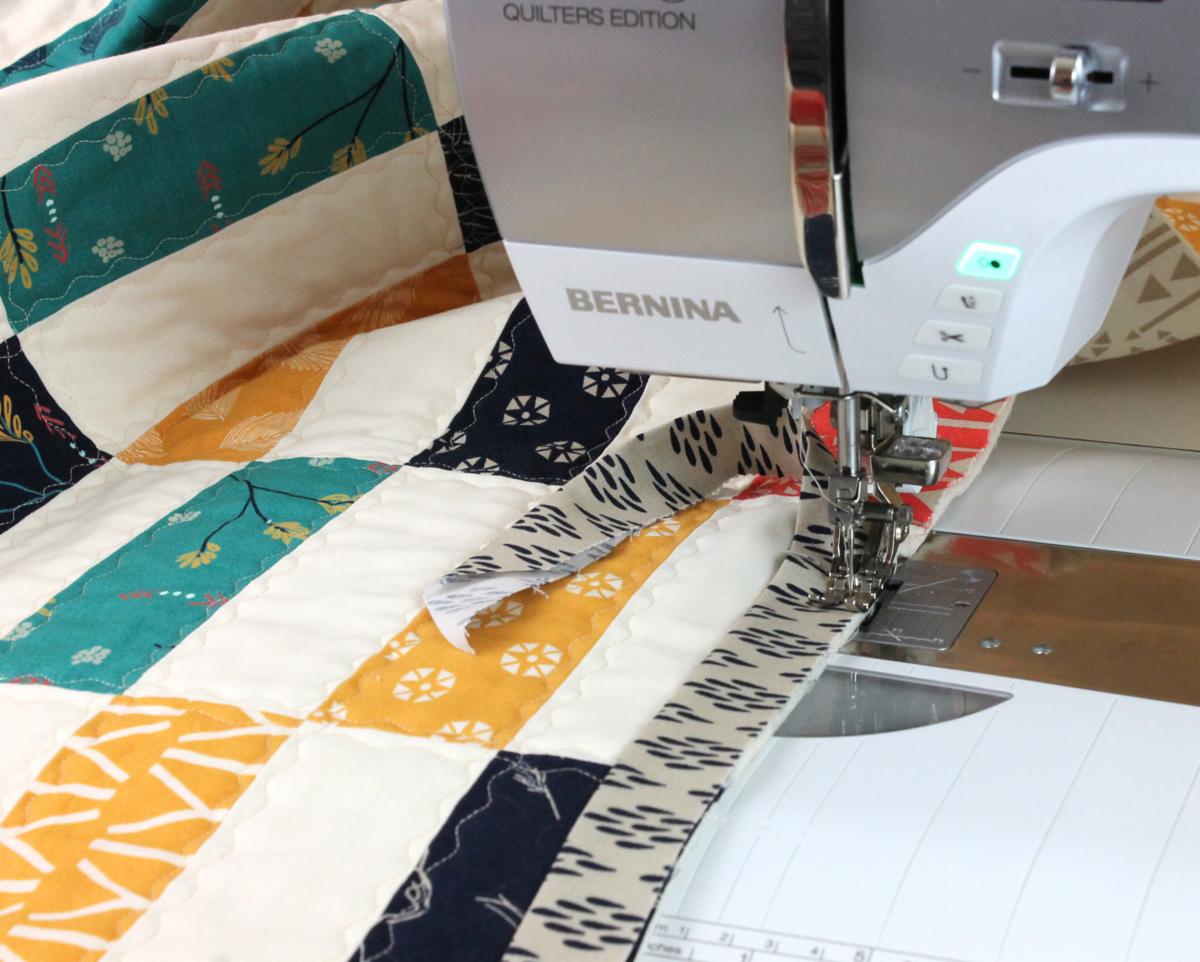
If you haven’t yet experienced the Row by Row phenomenon, it’s time to get on board! Quilt shop owner Janet Lutz started it all with a free horizontal row pattern in a summer vacation theme, which could then be combined with similar row patterns from other shops. Like a Shop Hop, you gather free patterns and then personalize your quilt with creative row placement, fabric combinations and embellishments. Janet demos both the use of fabric plates, and creating appliqué letters with freezer paper. TQS then visits Eileen Williams, who has challenged herself to make a small quilt each day for an entire year. Known for her beach and seascape quilts, Eileen shows how to add shimmer and sand, using Angelina fibers.
Star Members can watch Show 1811: Row by Row with Janet Lutz & Eileen Williams.
In 1995, a group of twelve patchwork lovers in various parts of Japan formed the Nihon Heritage Quilters Guild. This group participates in an annual quilt challenge, and every few years, the challenge is extended to include other nations. A list of 30 world-famous painters was chosen and given to a group of quilters from Japan, France, and the U.S. This exhibit was designed to compare the techniques and styles between the nations as they represent the works of the each famous painter. The exhibit will be touring AQS QuiltWeek events in 2016, but you can see a preview now.
 |
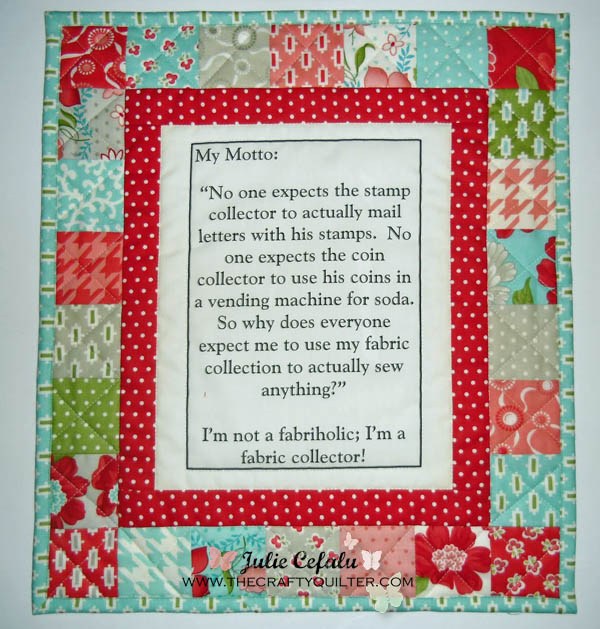
Row by Row creator, Janet Lutz, visited with Alex and Ricky on the set. Learn how a simple free horizontal row pattern with a summer vacation theme, started it all.
Star Members can watch Show 1811: Row by Row with Janet Lutz & Eileen Williams.
 |
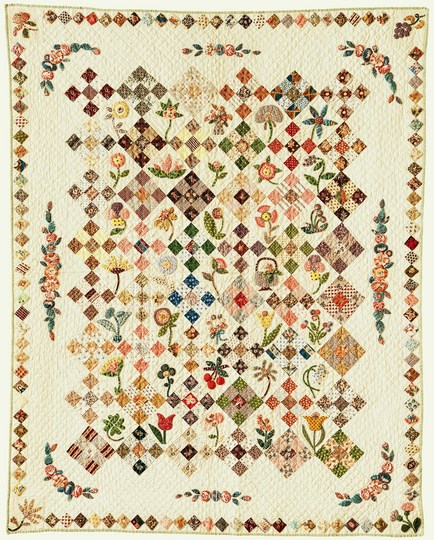
"Calico Garden Crib Quilt" (49" x 39") by Florence Peto,1950. Pieced appliqued and quilted cotton.
Shelburne Museum permanent collection. Photo courtesy Shelburne Museum.
Today it's hard to realize how little quilt history was available before the influence of our early 20th century pioneer quilt historians. Florence Peto is one of the most influential figures active before 1960. Peto wasn't alone in her pursuit of quilt history at that time. Marie Webster preceded her and Carrie Hall, Rose Kretsinger, Dr. William Dunton, Ruth Finley, and Berthe Stenge, just to name a few other TQHF Honorees, each busy in her/his own sphere. They all would eventually come in contact with Peto. Yet, Peto remains a unique voice in the quilt world from the 1930s-60s.
Taught by her New York Dutch grandmother to be a fine needlewoman at an early age, Florence Peto also had a life-long interest in antique textiles. Born in 1881 and married in 1900, her personal interest in textile research took on an added dimension as a result of her husband's position as a cotton converter and mill owner. Her access to his fabric sample books stirred her interest in dyes and printing methods, whetting her appetite for even more knowledge. Her self-directed studies eventually led her to focus on quilts and for that the quilt world can be very grateful.
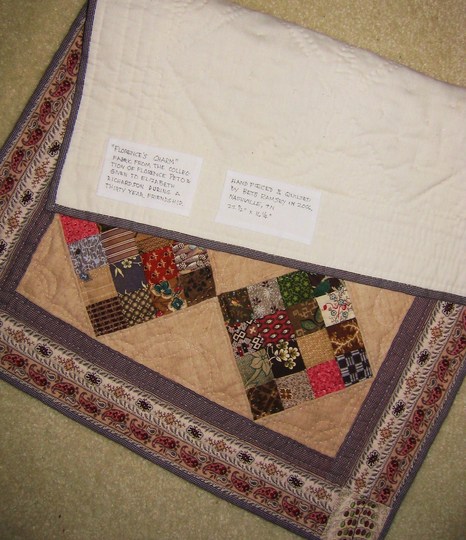
Photo by Karen Alexander
However, Peto didn't stop at just studying the fabric and pattern of the quilt. She went in search of the quilt's story. This is where the contacts she made through her lecturing often paid off. Peto believed that quilts were "cloth documents," and she wanted to know who, where, why and when about each quilt. Once she found a quilt, she interviewed family members and, when possible, sifted through archives, files, letters and even diaries to get the quilt maker's story. So great was her passion for these stories, her first book "Historic Quilts" (1939) focused on quilts she had personally gathered documentation on.
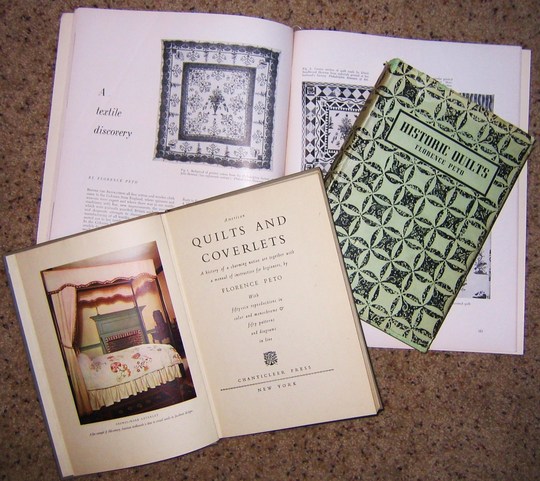
Photo by Karen Alexander
Eventually becoming an excellent quilt maker herself and winning several contests, Peto's "Calico Garden" (pictured at the top of the page) was selected in 1999 for inclusion in "The 20th Century's 100 Best American Quilts". Peto also wrote about quilts for the popular publications of the time — Antiques, American Home, Americana, Woman's Day, Hobbies and McCall's, lectured widely, designed needlework kits and greatly influenced the quilt collecting of several museums.
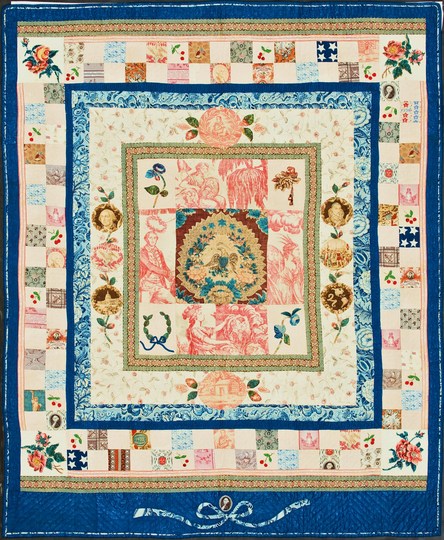
"Where Liberty Dwells" 1953 by Florence Peto. Private collection.
Photo courtesy Shelburne Museum.
Contemporary readers of the earliest quilt history books (such as Webster, Finley and Peto) will note that today's modern quilt historians have corrected some of the misnomers of these early historians. This in no way disparages their earlier work. We simply correct it and build upon it as new information is uncovered and new understanding develops.
This brief article is but a thumbnail sketch of a very talented productive woman. Surely Peto's life story presented in a full-length book, with lots of photos, is long overdue.
Karen Alexander,
Member of AQSG since 1981
Past President, The Quilters Hall of Fame
January 19, 2009
Want to know more?
Publications of both the American Quilt Study Group and The Quilters Hall of Fame offer more history on Florence Peto.
Avery, Virginia. "Florence Peto-Renaissance Woman of Mid Century," Quilter's Newsletter, January 1980.
Avery, Virginia. "Florence Peto, Path Finder," Ladies Circle Patchwork Quilts, Summer 1983: Carter Houck, Editor.
Clem, Deborah. "Florence Peto," The Quilters Hall of Fame, Rosalind Webster Perry and Merikay Waldvogel, Editors(1984),pg. 125.
Gross, Joyce. "Florence Peto and Woman's Day," Quilters' Journal, Mill Valley, CA, Vol. 3, No. 2. "Florence Peto," Quilters' Journal, Mill Valley, CA: Winter 1979, Vol. 2, No. 4.
Woodard, Thomas K. and Blanche Greenstein. "Twentieth Century Quilts: 1900-1950" New York: E. P. Dutton and Company, 1988.
Peto, Florence "American Quilts and Coverlets New York": Chanticleer Press, 1949.
_______ "Historic Quilts New York:" The American Historical Company, Inc., 1939.
_______ "The Crib-Size Quilt". Woman's Day, December 1951, pg. 72-75, 125-127.
______ "A Textile Discovery". Antiques Magazine, 1953, pg. 120-121.
Florence Peto letter to Elizabeth Richardson. March 19, (1951?): courtesy of Bets Ramsey.